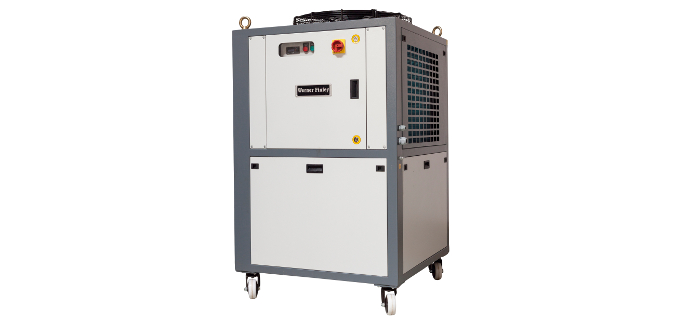- Cooling capacity range : 1.75 kW to 35 kW
- Fluid : Soft Water / water + glycol solution
- Refrigerant : R134a/R407c
- Operating ambient temperature range : +10 to + 50C
- Best fluid outlet temperature : 15degc, At ambient : 35degc & ∆T : 5 Deg C
- Condenser Type : Air-Cooled, Fin & Tube
- Evaporator Type : Brazed Plate Heat Exchanger
- Operating environment : Indoor / Out door - Shelter from rain, dust, insects, humidity, sunlight
- Power supply : 1 PH / 3 PH, 220V / 415 V, AC, 50/60 HZ
- MOC of wetted parts : SS 202 / 304 / 316 / CU
- Fluid loop : Open loop with media tank in the circuit
- Noise level : < 85 db
- Life expectancy : 10-15 years
Oil Chillers
Hydraulic Oil Chiller- I HOC
Most manufacturing units and processes use hydraulics based machinery. These machinery make use of hydraulic oils of varying densities which heat up periodically during the course of the manufacturing process. However, having the oil heat up causes it to lose some of its characteristic properties and renders it useless for the process. In order to increase the shelf life of hydraulic oil and the machinery that it belongs to, it is important to regulate the temperature of the oil and constantly cool it. This is achieved with the aid of hydraulic chillers which are usually connected directly to the oil supply and in-built pumps. The heated oil is circulated through the chiller circuit and its temperature is thus controlled. Werner Finley’s Chillers are built with internal gear pumps and plate heat exchangers for this application. These ensure higher cooling efficiencies and lower noise levels. These can be utilized for processes using oils of viscosities ranging from 32-68 CST.

Our Applications
Solar and Wind Energy, Health Care, Data Center, Power Electronics, Machine Tool, Induction Heating, Welding, Hydraulic Oil Cooling, Paint Manufacture, Pharma, Chemical, X-Ray Spectrometer, Vacuum Systems, Breweries, Food Processing, Plastic, Concrete Batching




